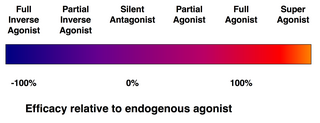Superagonist

In the field of pharmacology, a superagonist is a type of agonist that is capable of producing a maximal response greater than the endogenous agonist for the target receptor, and thus has an efficacy of more than 100%.[1][2] For example, goserelin is a superagonist of the gonadotropin-releasing hormone receptor.
See also
References
- ^ Carlier PR, Chow ES, Barlow RL, Bloomquist JR (August 2002). "Discovery of non-zwitterionic GABAA receptor full agonists and a superagonist". Bioorg. Med. Chem. Lett. 12 (15): 1985–8. doi:10.1016/S0960-894X(02)00299-8. PMID 12113824.
- ^ Tan CM, Wilson MH, MacMillan LB, Kobilka BK, Limbird LE (September 2002). "Heterozygous α2A-adrenergic receptor mice unveil unique therapeutic benefits of partial agonists". Proc. Natl. Acad. Sci. U.S.A. 99 (19): 12471–6. doi:10.1073/pnas.122368499. PMC 129469. PMID 12205290.
